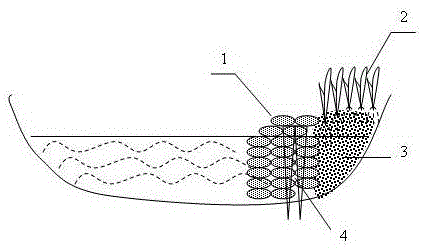A method for in situ treatment of river and lake sediment
A technology for sediment and lakeshore, which is applied in biological sludge treatment, river regulation, climate change adaptation, etc. It can solve the problem of freight and excavation costs, increase the cost of sediment dredging, ignore the combined effect of biology and ecology, and change the physical and chemical properties of sediment. nature and other issues, to achieve good environmental publicity and education functions, improve environmental awareness and environmental knowledge, and reduce impacts
- Summary
- Abstract
- Description
- Claims
- Application Information
AI Technical Summary
Problems solved by technology
Method used
Image
Examples
Embodiment 1
[0024] In an artificial lake with a water depth of 1m, the bottom mud mixed matrix is taken into an ecological bag, and the ecological bag is accumulated at a distance of 2 meters from the lake bank to form an ecological embankment. The embankment surface is 50cm above the water surface and anchored. The mixed matrix of sediment is composed of sediment, slag, a coarse material component, and vermiculite, a fine material component, uniformly mixed in a weight ratio of 40%: 40%: 20%. In between, then plant 1 bush willow and 5 sedges per square meter.
Embodiment 2
[0026] On the river bank with a water depth of 2m, the bottom mud, the coarse material components slag and gravel, and the fine component perlite are uniformly mixed in a weight ratio of 40%: 20%: 40% to form a bottom mud mixed matrix, and the bottom mud mixed matrix is taken. Into the ecological bag, the ecological bag is piled up 1 meter away from the river bank to form an ecological embankment, and anchored, and the embankment surface is 60cm above the water surface. Then fill the bottom mud mixture between the original river bank and the ecological embankment, and then plant 1 shrub willow and 5 sedges per square meter.
Embodiment 3
[0028] On the river bank with a water depth of 3m, the sediment, the coarse material components steel slag and gravel, and the fine material components perlite and volcanic ash are uniformly mixed in a weight ratio of 40%: 30%: 30% to form a sediment mixture matrix, and the bottom is taken. The mud mixed matrix is put into ecological bags, and the ecological bags are piled up at a distance of 1.5 meters from the river bank to form an ecological embankment, which is anchored, and the embankment surface is 70 cm above the water surface. Then fill the bottom mud mixture between the original river bank and the ecological embankment, and then plant 1 shrub willow and 5 sedges per square meter.
PUM
| Property | Measurement | Unit |
|---|---|---|
| diameter | aaaaa | aaaaa |
| diameter | aaaaa | aaaaa |
Abstract
Description
Claims
Application Information
 Login to View More
Login to View More - R&D Engineer
- R&D Manager
- IP Professional
- Industry Leading Data Capabilities
- Powerful AI technology
- Patent DNA Extraction
Browse by: Latest US Patents, China's latest patents, Technical Efficacy Thesaurus, Application Domain, Technology Topic, Popular Technical Reports.
© 2024 PatSnap. All rights reserved.Legal|Privacy policy|Modern Slavery Act Transparency Statement|Sitemap|About US| Contact US: help@patsnap.com








